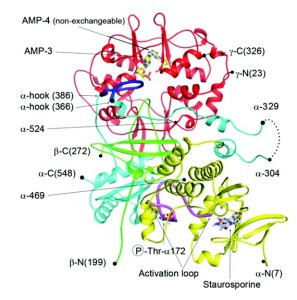It’s Monday, which means it’s time for a brain-dump of the things that have been percolating in my mind over the weekend. So, without further ado, I give you the inaugural installment of Monday Musings.
A common piece of advice on nutrition I hear from people ranging from layperson to “expert” is to invest in foods or supplements that have labels with few ingredients, whose ingredients contain four syllables or less, or something along those lines. I believe this advice is well-intended, but sometimes inaccurate.
The logic behind this notion is generally that food labels with lots of elaborate ingredients with really scientific-sounding names must be artificial and therefore detrimental to your health. Though it sometimes is the case that ingredients with complicated names were contrived in a lab, it isn’t always the case. The enzyme AMPk, for example–which is short for adenosine monophosphate-activated protein kinase–has a name that hardly rolls right off the tongue. Yet it plays a key role in regulating cellular energy levels and is naturally found in a myriad of tissues, including brain, liver, and skeletal muscle.

Moreover, just because an ingredient was artificially manufactured does not mean that it’s inherently going to cause cancer or some other health issue. The vast majority of life-saving medications, for example, are contrived in a laboratory. I’ll be the first to champion fixing health issues with nutrition and lifestyle changes when possible, and I’m also somewhat dubious in general of Big Pharma, but the truth is that without these synthetic chemicals and interventions our health care would not be nearly as good as it is today.
It’s this fear of the “artificially manufactured” that has bred things like the movements against GMOs and High Fructose Corn Syrup, which the evidence suggests are overblown concerns. I’m not saying that I’m not skeptical of these types of things–I generally avoid them myself–but I’m not going to claim they’re a ticking time bomb for cancer proliferation or the root cause of the obesity/metabolic syndrome epidemic. The science to make these claims just isn’t there–in fact in both of the aforementioned cases dozens of studies have shown that there is currently no reason for concern associated with consuming them within the context of a diet that is well-balanced in other aspects, like energy intake. My preference to eat foods that don’t contain these ingredients is more a byproduct of selecting foods with high nutrient and low energy densities, respectively–you’re typically not going to find HFCS in the vegetables that make up my salad–and if you expect me to turn down a nice, juicy steak just because the cow was fed GMO corn, then I wouldn’t hold your breath. On the other end of the spectrum are foods with fewer than three ingredients that I don’t consider to be healthy foods, either, such as soybean oil. The takeaway is that the oft-touted rule of thumb “don’t eat it if it has more than three ingredients” isn’t always accurate and may sometimes cause unhealthy decisions or undue distress.
With all of this in mind, you might be surprised to learn that I actually do follow the aforementioned advice of keeping my ingredient lists short, although it’s usually only with my supplements. The reasoning behind this practice is not a fear of artificial ingredients, but rather an adherence to an evidence-based approach: the effects shown in separate studies for separate compounds, even if they are extremely impressive, are not necessarily additive. In other words, just because a set of studies show that creatine monohydrate is extremely effective at boosting phosphocreatine levels and peak power output and another set of studies show that caffeine supplementation blocks adenosine receptors and increases mental alertness and physical strength does not mean that a supplement combining the two will give you the best of both worlds. The two (or twenty in some cases) compounds involved could be in competition for a common enzyme, for example, and so increasing the concentration of both at the same time would actually diminish the effect each one would normally have at those concentrations. This may in fact be the case for creatine and caffeine when coingested, although the research on this is pretty limited.
How do I know caffeine improves mental alertness? Just ask Dom at 1:26. #BroScience
Another example of such a pathway is the competition for the Large Neutral Amino Acid transporter. This one transporter is responsible for carrying the Branched-Chain Amino Acids (isoleucine, leucine, and valine) as well as the aromatic amino acids phenylalanine, tyrosine, and tryptophan (for you biochemistry nerds, histidine does indeed also have an aromatic ring side chain, but it is usually not classified as an aromatic amino acid) across cell membranes, particularly in the brain. If you increase the proportion of one these amino acids to the others, transportation of the others will suffer and the subsequent biological pathways those amino acids are a part of will suffer also. If you increase the concentrations of multiple types of these amino acids, the effect the increase would have for one amino acid in isolation is mitigated by the increases of the others.
Interesting (at least to me) side note: This pathway is actually thought to be a contributor to depressive symptoms that some people see on low-carbohydrate diets. Since most dietary proteins have a high BCAA:tryptophan ratio (i.e. dietary proteins are typically low in tryptophan) and insulin spikes are responsible for clearing BCAAs from the bloodstream, reducing carbohydrate intake can potentially shift the BCAA:tryptophan ratio to the left in a big way. Tryptophan is a precursor to serotonin, and so serotonin levels can be impaired as a result.
My main point is that, despite what the little girl in the AT&T commercials might tell you, more is not necessarily better. The only way to truly verify that a combination of ingredients is effective at improving a particular set of parameters is to design controlled studies that prove/disprove the given hypothesis. This is why instead of buying a product with lots of fancy ingredients (Xplosive Muscle Matrix Energy Proprietary Blend, anybody?), I just get what I know works. For example, one of my core supplements is a creatine/beta-alanine combo. Studies have been done to show that these two work well together, so I know I’m getting my money’s worth and not paying for extra junk. Long story short: in my opinion, keeping the ingredients list short and sweet can be good advice, but is often given for the wrong reason.
